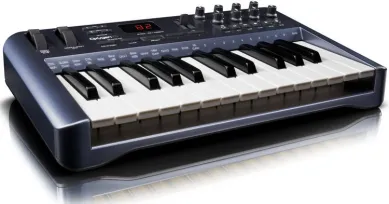A Songwriter's Best Friend: The Keyboard Controller
Dec 15, 2009So you’ve finally jumped into home recording. You have a simple setup like I’ve described before and you’re laying down great tracks. Let’s say you’re a guitar player who mostly records your acoustic and vocals. You’re probably getting the hang of capturing a great acoustic guitar and vocal track. But what if you want more out of your sessions…perhaps getting some strings, drums or even horns into your song would go a long way. Read on…
Unlocking Your DAW’s Potential
You’ve already heard me espouse the benefits of using your home studio as a songwriting tool. Pro Tools for instance comes bundled with a whole host of pro studio grade virtual instruments that are just waiting to be opened up. My favorite is Xpand, which is like having hundreds of instruments in one box. I use it for grand piano, cello, synth pads, drums, a rhodes, and even the occasional pan pipe or sitar! The point is you get all of these amazing sounds that can be used to “fill out” your song, giving it that professional polish; all without having to hire studio musicians!
All that being said, just knowing that your recording software comes bundled super fancy virtual instruments doesn’t mean those sounds are getting recorded. So how do you “play” them and get these instruments into your session? The simple answer…you need a keyboard controller. Let’s a take a quick look at some affordable options.
The Simple Option: M-Audio KeyRig 49
A keyboard controller is basically a plastic keyboard that doesn’t have any built in sounds. It only can trigger (or control) software MIDI instruments. If you just want a basic keyboard controller that will get the job done, you can’t do much better than the KeyRig 49. Via a simple USB connection to your computer (not your audio interface) you can have access to all the great virtual instruments that your software has to offer. It features 4 playable octaves at once (49 keys) and you can of course bank up or down for higher or lower octaves.
The Super Compact Option: Korg NanoKey
If desk real estate is low, or you just want a super portable option for recording on the go, then look no further than Korg’s latest release, the NanoKey. This velocity sensitive “keyboard” is truly clever; boasting a lot of features for not a lot of money (or physical space). To the seasoned keyboard player this will feel a bit odd at first, but it will get the job done for triggering instruments and playing basic riffs.
The “Do It All” Option: M-Audio Oxygen 25
If you had to pick just one keyboard controller it might just be this puppy. Combining features such as multiple rotary knobs and assignable sliders, transport controls, and direct link to Pro Tools and Logic along with the small footprint of a 25 key controller, it doesn’t get much better (and simpler) than this. I personally use the older version of the Oxygen and can say with great confidence that it gets the job done right every time.
What Next?
Once you’ve decided on a controller that fits your budget, you simply need to install any drivers that came with it, and run any setup that your DAW might need for it. Once your software has recognized it once, it will recognize it every time you have it on and plugged in while you’re running a session. This is beautiful because it means you don’t have to think.
If you’re in Pro Tools, all you’ll be doing is creating a new Instrument Track (mono or stereo). Then simply insert the virtual instrument as a plugin (just like you insert your other plugins). Record enable your track, and start banging on the keys. You should hear the notes you’re triggering through the virtual instrument patch. When you’re ready to lay down something you just record as usual, but what you’re actually doing here is laying down MIDI data, which is digital information that tells your plugin what notes to play in the selected patch. You’re not actually recording any audio. This is fantastic because it means you can easily adjust notes or timing of your performance as well as completely change the instrument or sound while keeping your original performance. Talk about sweet!
Now You Know
Simply put, a songwriter’s best friend is his or her keyboard controller. Grab an affordable one (not much more than $100 or less), plug it in to an available USB port, and start tapping into all of the wonderful included instruments in your DAW. This opens a world of opportunities to people who would otherwise be limited to a guitar and vocal recording. Now you know…so get to it!
Discover The 6 Steps for Creating a
Radio-Ready Song from Scratch"
Enter Your Email Below To Receive The Free 17-page PDF,
"6 Steps To A Radio-Ready Song"
We hate SPAM. We will never sell your information, for any reason.




